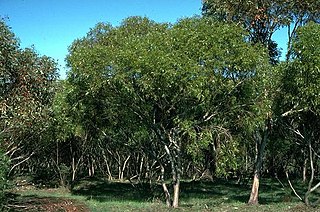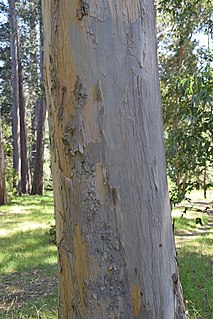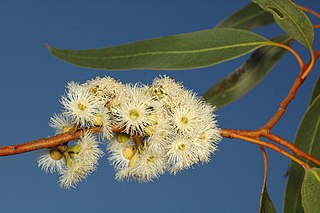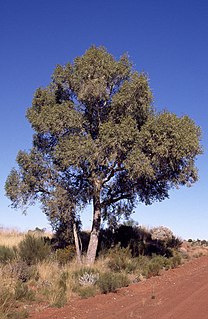
Eucalyptus dumosa, commonly known as the white mallee, dumosa mallee, or Congoo mallee, is a species of mallee that is endemic to south eastern Australia. It usually has rough, flaky grey bark on the lower trunk, smooth bark above, lance-shaped to curved adult leaves, flower buds in groups of seven, white flowers and cup-shaped, cylindrical or barrel-shaped fruit.

Eucalyptus oraria, commonly known as ooragmandee, is a species of mallee that is endemic to coastal and near-coastal areas of Western Australia. It has smooth greyish bark, sometimes with rough, flaky bark on the base of the trunk, lance-shaped adult leaves, flower buds in groups of nine or more, white flowers and barrel-shaped fruit.

Eucalyptus nitida, commonly known as the Smithton peppermint, is a species of tree or mallee that is endemic to Tasmania. It has varying amounts of loose, fibrous or flaky bark, lance-shaped to curved adult leaves, flower buds in groups of nine to fifteen, white flowers and cup-shaped to hemispherical fruit.

Eucalyptus morrisii, commonly known as grey mallee, is a species of mallee or straggly tree that is endemic to western New South Wales. It has rough, fibrous or flaky bark on some or all of the trunk, smooth greyish bark above, lance-shaped adult leaves, flower buds usually in groups of three, white flowers and conical or hemispherical fruit.

Eucalyptus baudiniana is a tree, rarely a mallee, that is endemic to Western Australia. It has rough bark on its trunk, smooth brownish bark above, narrow lance-shaped to curved adult leaves, oval buds in groups of seven to fifteen, white flowers and barrel-shaped fruit.

Eucalyptus fruticosa is a species of mallee that is endemic to Western Australia. It has rough, fibrous or flaky bark on the trunk, sometimes also on the larger branches, smooth pale brownish bark above, linear to narrow elliptical adult leaves, flower buds in groups of between seven and eleven, white to cream-coloured flowers and barrel-shaped to shortened spherical fruit.
Eucalyptus glomerosa, commonly known as jinjulu, is a species of mallee that is endemic to inland Australia. It has rough, fibrous and flaky bark near the base, smooth bark above, egg-shaped to lance-shaped adult leaves, flower buds usually in groups of seven, cream-coloured flowers and conical to hemispherical fruit. It is mainly found in the Great Victoria Desert of South Australia but also grows in eastern parts of Western Australia.

Eucalyptus jucunda, commonly known as Yuna mallee, is a species of mallee or small tree that is endemic to Western Australia. It has smooth bark, lance-shaped to curved adult leaves, flowering buds in groups of seven or nine, white or cream-coloured flowers and barrel-shaped or shortened spherical fruit with an unusually narrow opening.

Eucalyptus luteola is a species of mallee that is endemic to a small area of Western Australia. It has smooth grey bark with rough greyish ribbons near the base, linear to narrow lance-shaped adult leaves, flower buds in groups of eleven to thirteen, lemon-coloured flowers and cylindrical to barrel-shaped fruit.

Eucalyptus mannensis, commonly known as Mann Range mallee, is a species of mallee that is native to Western Australia, South Australian and the Northern Territory. It has rough bark at the base of the trunk, smooth bark above, narrow lance-shaped adult leaves, flower buds in groups of between seven and eleven, creamy white flowers and hemispherical fruit.

Eucalyptus petraea, commonly known as granite rock box, is a species of mallee or a small tree that is endemic to Western Australia. It has thin, ribbony or flaky to fibrous bark on the lower trunk, smooth greyish above, lance-shaped adult leaves, flower buds usually in groups of seven, creamy white flowers and conical fruit.

Eucalyptus platycorys, commonly known as Boorabbin mallee, is a species of mallee, rarely a small tree, that is endemic to Western Australia. It has rough, dark grey, fibrous and flaky bark on the trunk, smooth greyish bark above, lance-shaped adult leaves, flower buds usually in group of three, creamy white flowers and cup-shaped to cylindrical fruit.

Eucalyptus rugosa, commonly known as the Kingscote mallee, is a species of mallee that is endemic to coastal areas of southern Western Australia and South Australia. It has smooth bark, lance-shaped adult leaves, flower buds in groups of between seven and thirteen, white flowers and cup-shaped, conical or hemispherical fruit.

Eucalyptus trivalva, commonly known as Victoria Spring mallee or desert mallee, is a species of mallee or small tree that is endemic to arid areas of central Australia. It has rough, partly shed bark on some or all of the trunk, smooth bark above, lance-shaped to elliptical adult leaves, flower buds in groups of nine or eleven, white flowers and cup-shaped, cylindrical or conical fruit.

Corymbia chippendalei, commonly known as the sand-dune bloodwood or sandhill bloodwood, is a species of small tree or a mallee that is endemic to desert country in central Australia. It has rough bark on part or all of the trunk, lance-shaped adult leaves, flower buds in groups of seven, white flowers and shortened spherical fruit.
Corymbia hamersleyana is a species of small tree or mallee that is endemic to the Pilbara region of Western Australia. It has rough, flaky bark on part or all of the trunk, smooth cream-coloured bark above, lance-shaped adult leaves, flowers buds in groups of seven or nine, creamy white flowers and urn-shaped fruit.

Eucalyptus ceratocorys, also known as the horn-capped mallee, is a mallee that is native to South Australia and Western Australia. It has rough, ribbony bark at the base of its trunk, smooth greyish bark above, lance-shaped adult leaves, flower buds in groups of seven or nine with ridges along the sides, white to cream-coloured flowers and cylindrical fruit.

Eucalyptus cylindrocarpa, commonly known as the woodline mallee, is a species of mallee that is endemic to Western Australia. It has mostly smooth bark, sometimes with loose fibrous or flaky bark near the base of the trunk, linear to lance-shaped or curved adult leaves, flower buds in groups of seven, nine or eleven and cylindrical to barrel-shaped fruit.
Eucalyptus capitanea, commonly known as the desert ridge-fruited mallee, is a species of mallee that is endemic to South Australia. It often has rough, flaky bark on the lower part of the trunk, smooth bark above, lance-shaped adult leaves, ribbed, oval flower buds in groups of seven, cream-coloured flowers and ribbed, urn-shaped fruit.
Eucalyptus silvestris is a species of mallee or small tree that is endemic to Victoria, Australia. It has rough, fibrous or flaky bark on the trunk and larger branches, smooth greyish brown bark above, glossy green, lance-shaped leaves, flower buds usually in groups of seven, white flowers and conical to cup-shaped fruit.
















